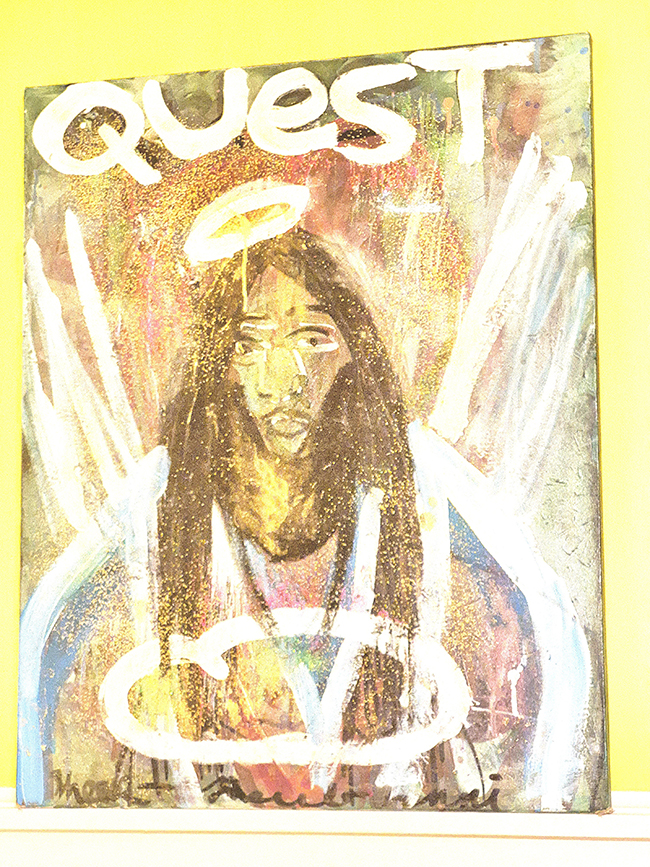Shear-jasub Nobles is a New York–based artist who doesn’t chase after art-world trends or polish. His work feels like a search—raw, immediate, and spiritual. He paints like he’s digging through something, not decorating. What you see in his art isn’t just image—it’s motion. Emotion. Friction. A layered call for meaning. Living and working in the thick of New York City’s ever-clashing cultures, Nobles builds paintings that feel almost devotional. At the core of it all is a kind of quest—both personal and collective.

One of his works, seen here, puts that word right at the top: “QUEST.” It’s a declaration, not a title. A statement of purpose. The figure beneath the word doesn’t smile. Doesn’t pose. This is not a passive portrait. It looks straight at you. The long dark hair, the golden face emerging through layers of thick, bright brushwork—this is someone held up, suspended between material and spiritual space.
Nobles leans into texture and symbolism in a way that recalls urban murals more than gallery fare. You get halos and wings, glowing outlines, gestures from Christian iconography—but here, they’re messy. Handmade. Urgent. The yellow halo above the head floats off-center, slapped on like a thought that interrupted the painting mid-stroke. Below, a second halo (or maybe a crown of questioning) crosses the body. It almost doubles as a barrier, a container, or maybe even a wound. These signs—angelic or divine—aren’t crisp. They’re weathered. Human.
The brushwork is thick and physical. There’s a force to it, like it was done quickly but with intention. No part of the canvas feels still. The background churns with glittering reds and shifting forms, suggesting chaos or a spiritual fog. Nobles allows this sense of motion and disorder to sit alongside the centered figure. He’s not cleaning up the world behind the image—he’s showing it, full of noise and distortion.
Color plays a key role in setting the emotional tone. Nobles isn’t afraid of contrast. The golds and reds feel sacred. The blues cool the eye. White wings stretch behind the figure like punctuation marks, rough but bold. And yet nothing is purely clean. Everything is touched with dirt, brush dust, paint splatter, or raw layering. It’s all alive and unresolved.
In some ways, Nobles’ style feels influenced by both graffiti and gospel. There’s a street-level roughness that mixes with deep spiritual questions. His figures aren’t frozen saints—they’re witnesses. They seem to ask: what are we looking for? Who are we trying to be? What is this search about?
The word QUEST drives it home. It’s not a title tucked in the corner. It’s part of the image, as important as the eyes. It tells you how to read everything else—not as answers, but as part of a pursuit. The painting wants you to pause, maybe even reflect. And it does this without elegance. There’s no perfection here. No photo-realism. Just raw energy and faith in the act of painting.
You can also see influences of Afro-spiritual traditions, folk iconography, and outsider art in the way Nobles puts this together. It’s deeply intuitive, guided more by emotion than design. His hand doesn’t flinch. The result is deeply personal and wide open at the same time.
In a city like New York, with its speed and spectacle, this kind of work doesn’t just stand still—it insists. Nobles gives us a portrait that doesn’t flatter. It confronts. It glows in places, stumbles in others, but always stays grounded in belief—that painting can be a mirror, or maybe a compass. That paint itself can ask a question, and maybe even offer a way forward.
So what are we seeing in this piece? A guardian? A prophet? A version of the artist himself? It’s unclear, and maybe that’s the point. Nobles is not painting easy icons. He’s painting the tension of being. The gravity of faith. The loneliness of hope. And through it all, he dares to call it what it is: a quest.
That word lingers. You don’t forget it. You don’t look away from it either. Like the painting, it stays with you. Not to explain. But to keep asking.

